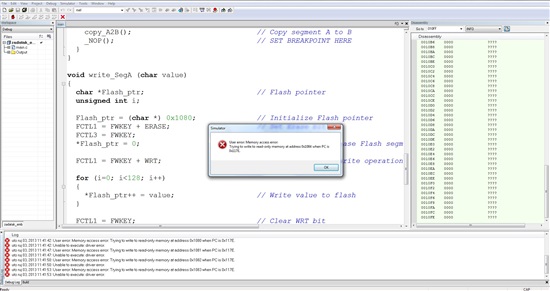Hi,
I'm using MSP430f149 and I want to write data like presented below to flash information memory.
| parameter | record | note |
| Name | "Name" | |
| Date | "01.01.2012" | |
| Author | "Alex Biz" | name |
| Version | "0100" | 1.00 |
| Serial number | "12345" |
So I'm going to put strings (record from table) of data into memory.
How to do that?
Regards.
Maybe
#include "io430.h"
#include <string.h>
#define INFO_MEM_SEG_A (0x010FF)
#define INFO_MEM_SEG_B (0x0107F)
int main( void )
{
int size_of_string=0x0000;
//Data information memory
char* naziv="Prrikup podataka";
char* datum_proizvodnje="20.02.2012.";
char* proizvodac="Alo Malo";
char* verzija_sw="0100";
char* verzija_hw="0100";
char* serijski_broj_uredaja="12345678";
char* adresa_mjernog_mjesta="00000001";
// Function prototypes
void write_SegA (char *value, int flash_ptr_val, unsigned int size_of_string);
// Stop watchdog timer to prevent time out reset
WDTCTL = WDTPW + WDTHOLD;
// Upis podataka u trajnu INFO flash memoriju
size_of_string = strlen(naziv);
write_SegA (naziv, INFO_MEM_SEG_A, strlen(naziv));
size_of_string += strlen(datum_proizvodnje);
write_SegA (datum_proizvodnje, INFO_MEM_SEG_A + size_of_string, strlen(datum_proizvodnje));
size_of_string += strlen(proizvodac);
write_SegA (proizvodac, INFO_MEM_SEG_A + size_of_string, strlen(proizvodac));
size_of_string += strlen(verzija_sw);
write_SegA (verzija_sw, INFO_MEM_SEG_A + size_of_string, strlen(verzija_sw));
size_of_string += strlen(verzija_hw);
write_SegA (verzija_hw, INFO_MEM_SEG_A + size_of_string, strlen(verzija_hw));
size_of_string += strlen(serijski_broj_uredaja);
write_SegA (serijski_broj_uredaja, INFO_MEM_SEG_A + size_of_string, strlen(serijski_broj_uredaja));
size_of_string += strlen(adresa_mjernog_mjesta);
write_SegA (adresa_mjernog_mjesta, INFO_MEM_SEG_A + size_of_string, strlen(adresa_mjernog_mjesta));
return 0;
}
void write_SegA (char *value, int flash_ptr_val, unsigned int size_of_string)
{
char *Flash_ptr; // Flash pointer
unsigned int i;
Flash_ptr = (char *) flash_ptr_val; // Initialize Flash pointer
FCTL1 = FWKEY + ERASE; // Set Erase bit
FCTL3 = FWKEY; // Clear Lock bit
*Flash_ptr = 0; // Dummy write to erase Flash segment
FCTL1 = FWKEY + WRT; // Set WRT bit for write operation
for (i=0; i<size_of_string; i++)
{
*Flash_ptr++ = *value++; // Write value to flash
}
FCTL1 = FWKEY; // Clear WRT bit
FCTL3 = FWKEY + LOCK; // Set LOCK bit
}


